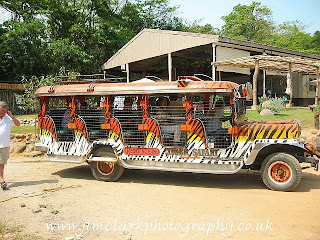The jeepney rose from the ashes of Manila at the end of the Second World War. After Japan's surrender in 1945, the US military began sending thousands of American servicemen back home to the US. However, much of their surplus equipment stayed behind in the Pacific. In Manila, which had been flattened when the Americans retook the city street by street from the Japanese, the US sold or simply gave away a huge number of surplus jeeps to local Filipinos.
World War II Jeep
There are many explanations of the origin of the word "jeep," all of which have proven difficult to verify. The most popular belief is that the vehicle bore the designation "GP" (for "Government Purposes" or "General Purpose"), which easily becomes the word jeep.
These jeeps rapidly emerged as a popular and creative way to re-establish inexpensive public transportation, which had been virtually destroyed during the Second World War. Drivers soon began painting their olive-drab jeeps in a bright colours designed to grab the attention of potential passengers. Drivers added metal roofs to ward off the sun and rain; they extended the rear of their vehicles in order to crowd more people aboard with ease.
Sixty five years after the end of the War, jeepneys are still hauling passengers throughout the Philippines. Though these sturdy machines face increasing competition from more modern taxis and minivans, jeepneys remain the backbone of public transportation. Today's jeepney drivers face an ever-increasing amount of rules and regulations. The government issues licenses for jeepney drivers to use established routes at set fares that begin at a very reasonable 3 pesos (about 5p). A jeepney driver who picks up passengers off his licensed route faces stiff penalties as well as the potentially violent backlash from the driver whose fares he is poaching.
The jeepney is also used for transporting goods, jeepneys loaded with fresh pinneaples are a common sight. Specially adapted jeepneys can also be utlised for other purposes, like safe tiger viewing platforms in zoos!






















No comments:
Post a Comment